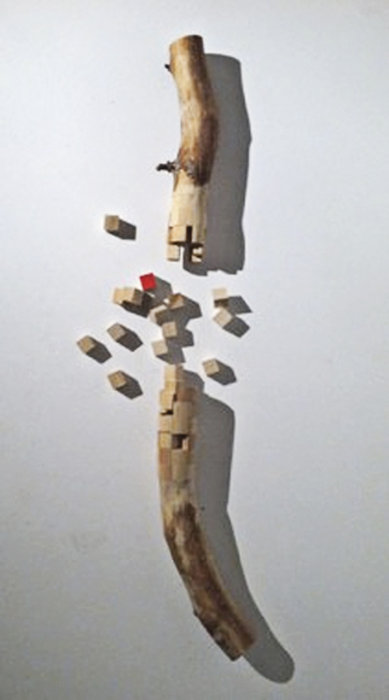Visual artist Sasha Chavchavadze says she has “been playing with matches for years.” Although when she says that, she means she has used the little fire starters in her work. But she readily admits that her use of little matchsticks is meant to evoke a sense of danger, the possibility of risk.
“I think that we tend to ‘play it safe’ in our society, and that sometimes taking risks can lead to positive change, though I would not recommend taking ‘dangerous’ risks,” said Chavchavadze. “Sometimes confronting one’s fears can open up whole new worlds. I don’t mean doing things like extreme sports or putting one’s life in danger. I’m referring to small risks, like singing in front of an audience, performing in a play, or flying to another country to see how others live. Also, the definition of ‘dangerous’ has changed. For instance, when I was a child, I played on the city streets in my neighborhood without my parents knowing where I was. Today for many parents this would be considered dangerous. Today kids usually have cell phones, which gives a sense of false safety.”
Chavchavadze has now used this perspective to inform the exhibit “Dangerous Toys,” currently on display at Curious Matter, a gallery at 272 Fifth St. in downtown Jersey City. The exhibit, which was curated by Chavchavadze, includes the works of 12 artists who have also created pieces that are seem to be simultaneously life affirming and deadly, smooth and sharp, supportive and free-falling.
Chavchavadze said she is typically very careful with the matches she uses in her art. But she recently recounted a story that taught her a painful lesson – a lesson that was at the same time freeing.
“Recently, I invited an artist to contribute a sphere of multi-colored matches to my museum, fabricated with old dual-tone pre-safety matches ordered on eBay,” Chavchavadze said. “Weeks later, [a fire] rolled along a wall and self-ignited, setting off an enormous explosion of flame that engulfed my museum. The experience, though traumatic, was strangely freeing…There’s a lot of focus on ‘safe toys’ for children these days. Rubber mats are placed under jungle gyms. Warning labels abound. We are a ‘no risk’ society, keeping death and destruction always at bay. Yet, in order to achieve this, we make weapons available as toys, and we guard our shores with a nuclear arsenal that could destroy worlds. I find that really ironic. I wanted to sort of explore that in this exhibit.”
Taking risks
The exhibit includes the work of 12 artists.
In an essay that accompanies the show, Chavchavadze wrote that, “the things that should be ‘dangerous’ in our culture because they can effect the most dramatic change, are also reduced to toys. The most revolutionary art looks like a play thing when hung in our mega-museums, as if its power had been leached out of it. Perhaps today the term ‘dangerous toys’ could be a euphemism for art that inspires, that has meaning, that challenge.”
Much of the danger is implied, not literal, in the pieces that Chavchavadze selected for the show.
“Shiva Eye,” an ink drawing by Lance Rutledge, evokes the mystical Middle Eastern “eye of God,” the all-seeing judge. But the Hindu god Shiva is known as both the destroyer and the god of transformation. The drawing evokes both the danger inherent in destruction, but also the rewards that can come from profound transformation. Zoe Bellot’s “Bird,” is a turntable music box that plays the tune “How Sweet it Is.” The installation is sad since it evokes that which has died or passed away. Death, of course, is a possible outcome to danger. Other pieces – such as Anthony Heinz May’s sculpture “Game of Stick” or “Hand Games,” a drawing by Neal Anthony Pitak – are less open to interpretation.
“I would say that the pieces I chose all have an element of playfulness – they all relate to toys and games in some way,” Chavchavadze said. “They all speak to the darker side of fun and entertainment in our society. But then again, some of the best children’s toys can be very ‘dark.’”
The exhibit Dangerous Toys will be on display through Nov. 11. The show also includes work from Aaron Beebe, Debra Regh, Margaret Roleke, Heather Molin, Douglas Newton, Chavchavadze, and Curious Matter co-founders Raymond E. Mingst and Arthur Bruso.
For more information, including the gallery hours, call (201) 659-5771.
E-mail E. Assata Wright at awright@hudsonreporter.com.
